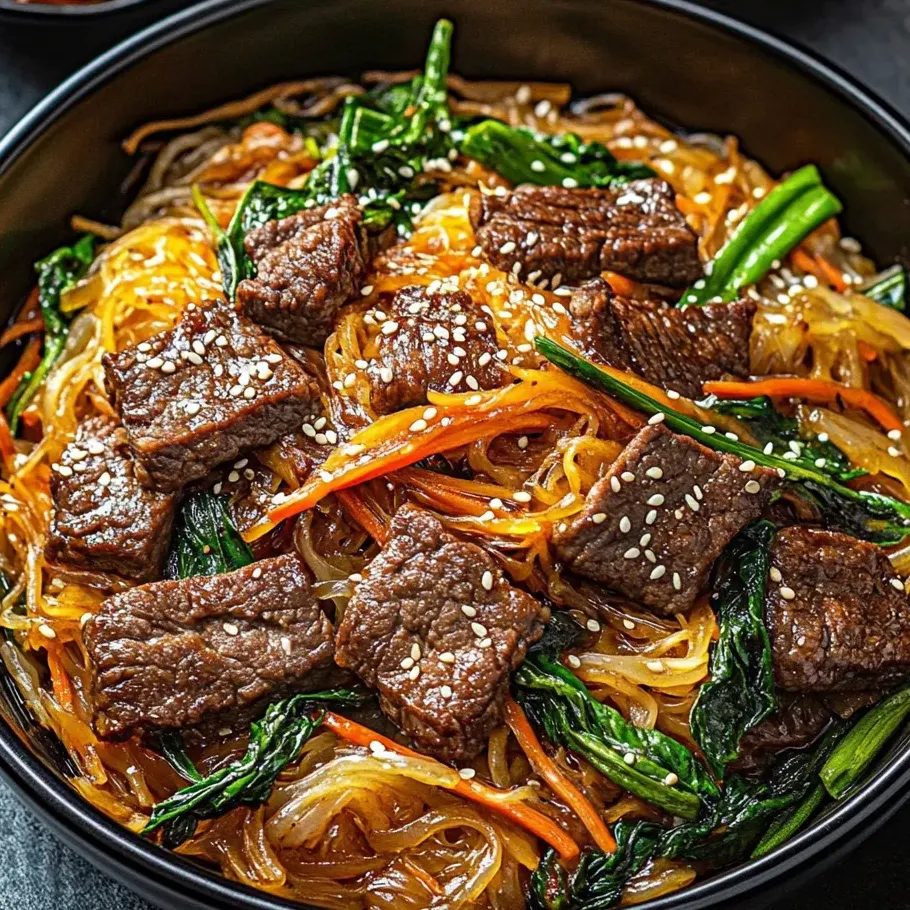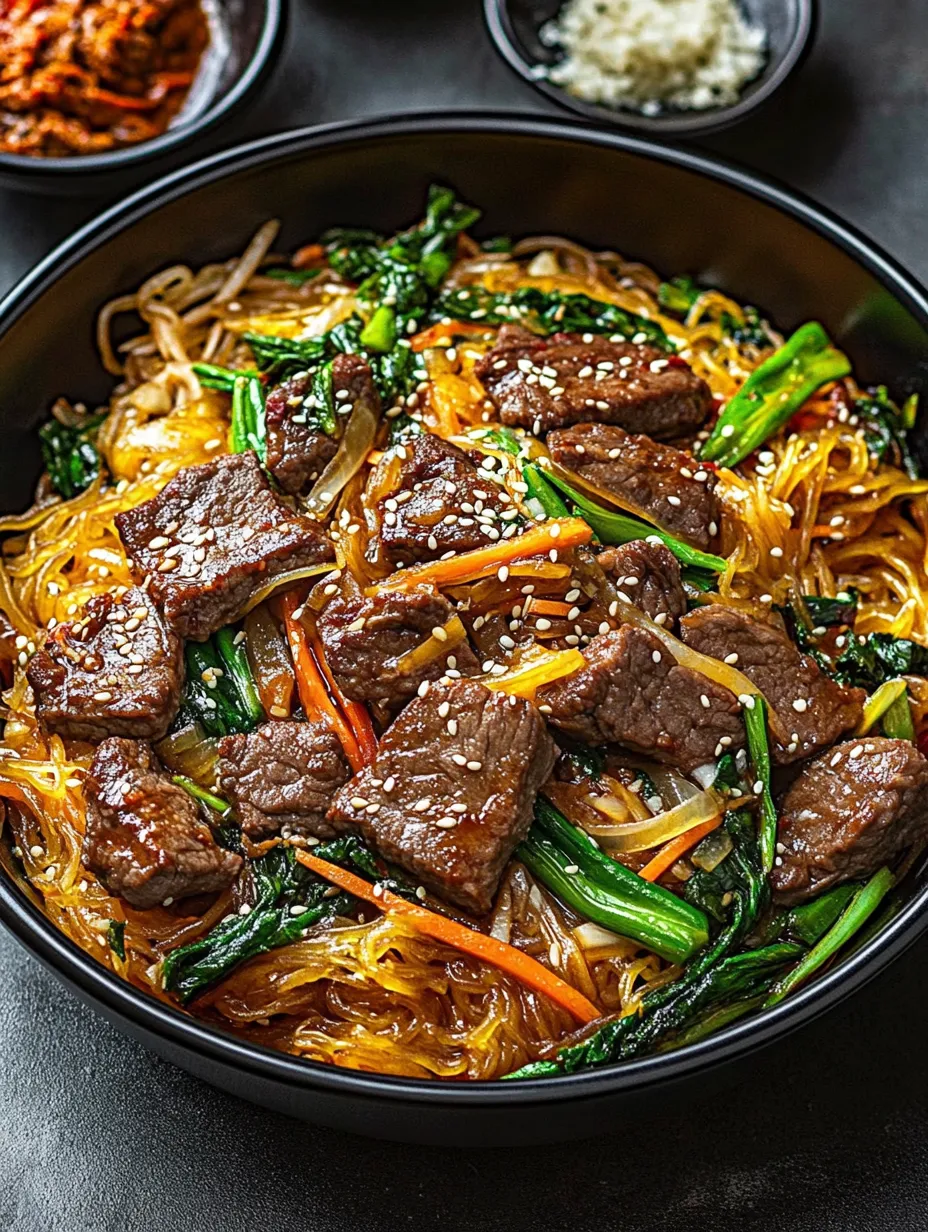 Pin it
Pin it
Korean glass noodles called japchae are super lively and always get everyone grinning when I bring them to potlucks or set them out for the family. Those chewy noodles made from sweet potato soak up all the tasty sauce. Sliced beef and a rainbow of crisp veggies pack in tons of good flavors and fun textures. When I want cozy food that still feels fresh and bursting with veggies, I turn to this one.
The first time I put together japchae was for a buddy’s birthday party after catching it on a travel show. Now whenever we party, everyone wants seconds and the whole house smells incredible as it cooks.
Vibrant Ingredients
- Brown sugar: Brings just enough mellow sweetness Grab the soft kind, not the dried out bits
- Soy sauce: This gives that awesome salty umami flavor Use tamari for a gluten-free fix, or snag a good Korean or Japanese bottle if you can
- Olive oil: Great for sautéing your veggies and stops the noodles from sticking Go with something neutral-tasting
- Sesame oil: For that signature nutty punch Toasted Korean-style is best if you've got it
- Garlic: Delivers the bold aroma Korean food's known for Plump fresh cloves work best
- Spinach: Gives a pop of color and tender texture Reach for baby spinach with deep green leaves
- Green onions: Lively and bright Pick ones with vivid dark tops
- Carrots and white onion: Sweet and crunchy Don’t skip these—find firm, heavy ones
- Korean glass noodles (sweet potato): The clear, bouncy noodles that set japchae apart Look for even, unbroken noodles at most Asian grocers
- Thin beef slices: Plump up the meal Make it with nicely marbled beef, or try tofu, shrimp, or even chicken for a twist
Simple How-To Steps
- Finish and Garnish:
- Warm everything up once mixed, just until heated through. Pile on extra green onions for color and serve it up warm or even cooler for picnics.
- Mix It All:
- Dump your drained noodles in a roomy bowl. Add all your beef, veggies, and wilted spinach. Get in there with tongs (or gloved hands) and toss until the sauce coats every part.
- Quickly Wilt Spinach:
- Pop the spinach into your skillet. Give it a stir until the leaves just fold and turn a deep green. Don’t wait too long—they should stay tender, not mushy.
- Cook the Veggies:
- In a fresh pan with olive oil over pretty hot heat, toss in carrots and onion strips. Cook until they’re just soft, about three to four minutes. Drop in the garlic and green onions, then coat it all in the last bit of soy, sesame oil, and brown sugar. Two more minutes makes it glossy and fragrant.
- Sear Your Protein:
- Crank up a skillet until very hot, drop in the beef slices, and spread them out so they all hit the heat. Shake on half your soy sauce, brown sugar, and sesame oil. Move them around until the edges brown fast, then scoop out onto a plate for now.
- Boil the Noodles:
- Get a big pot of water bubbling with a splash of olive oil. Toss in glass noodles and cook five to six minutes ‘til they’re chewy but still have bounce. Drain super thoroughly so the noodles don’t water down your flavors and set aside.
 Pin it
Pin it
The chew of these noodles might be my top favorite part. They slurp up all the sauce and stay bouncy. My kids always argue for the last carrot and beef bits, which honestly makes this dish pure fun at my table. I once made japchae just to jazz up a quiet Sunday and we wound up turning it into a mini party. I keep coming back to this one for that happy memory.
Storing Leftovers
Japchae lasts nicely in a sealed container in the fridge for up to three days. Since the noodles are sturdy, they won’t fall apart when reheated. Just a quick toss in a hot pan or a zap in the microwave brings everything right back to life.
Easy Swaps
If you’re not into beef, use thin chicken, tofu, or shrimp instead. Other stir fry veggies like red bell peppers, zucchini, or mushrooms work great too. For gluten-free, switch out the soy for tamari.
How to Serve
Japchae can be the main event hot or cold. Try serving it next to some crispy kimchi or vinegary pickled radish for a real Korean vibe. Want crunch? Bundle it in fresh lettuce leaves.
 Pin it
Pin it
Cultural Backstory
Japchae goes way back in Korean food history. Once it was something only royalty got to enjoy. Now you’ll see it at special get-togethers like birthdays or Lunar New Year—it always brings a sense of celebration to the table.
Frequently Asked Questions
- → Why do glass noodles turn out chewy in japchae?
Only Korean sweet potato noodles bring that signature bounce. Cooking them till they’re just right helps them stay springy.
- → Is it possible to swap out the protein in japchae?
Totally! You can toss in chicken, swap for tofu, or even try shrimp—whatever fits how you like to eat.
- → Should japchae get served hot, or is it cool too?
Either way works! You can have japchae right off the stove, or let it cool down—great for sharing or meal prepping lunches.
- → Any tips to keep the veggies from getting soft in japchae?
Crank up the heat and cook veggies quick, so they get just a bit soft but still snap when you bite ‘em.
- → Which sauce mix is the secret behind japchae’s taste?
It’s really about soy sauce, some sesame oil, and a little brown sugar fighting for the top spot—salty, sweet, and nutty all at once.
- → Is there a gluten-free way to make japchae?
Yep, swap regular soy sauce out for tamari or check your noodles and sauces to keep things gluten-free.
